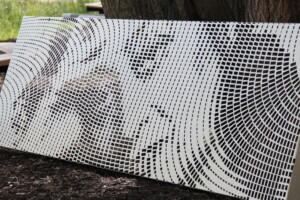ACADIA, or the Association for Computer Aided Design in Architecture, is set to meet in Mexico City at the Universidad Iberoamericana from October 18–20. Each year ACADIA brings together leading scholars, researchers, and practitioners who push the boundaries of architecture through design and computation. AN spoke with conference organizers Brian Slocum and Pablo Kobayashi, along with Technical Chair Phillip Anzalone, about the excitement of bringing the conference to Mexico for the first time.
AN: Why is this year’s conference so special?
This is the first time in ACADIA’s nearly 38 year history hosting the gathering in Mexico. The type of work that will be presented is something that hasn’t been seen locally and is not yet part of the culture of the institutions. Mexico, of course, has a rich tradition of craft, artisanal labor, and analog computation within architectural practices. We hope that by bringing ACADIA to Universidad Iberoamerica and UNAM that we can start a conversation for moving architecture forward.
The theme of this year’s conference is Recalibration: On Imprecision and Infidelity. What do you mean by recalibration?
The digital tools we use are very precise and by their very precision, there comes an obsessive need to control the output. In a certain sense, as a field we are facing a surplus of precision. We want to ask: Can error and imprecision (so-called glitches & failures) be seen as the creative act and be part of the dialogue?
We have seen a shift in proposals and projects from those that place an emphasis on the tools of architectural design (robots, 3-D printers, BIM), which embody the precision and fidelity that the conference theme reacts to, toward those related disciplines and trajectories that break free from computational preconceptions and begin to encourage a redefinition of the traditional tools and processes that are at the heart of experimentation and production. Through technologies such as mixed reality and artificial intelligence, processes such as reuse and repurposing of materials, integration of computer and human interaction, and other trends, the current researchers inhabit a fluid zone where total control and the dichotomy of virtual and real is blurred, allowing for innovation and discovery to flourish.
Also in terms of recalibrating the discourse, how do we deal with bigger, more social problems and evaluate the social impact of computation? How do you evaluate the results of an investigation that stems from a worldview rather than starting just from the data? How can we negotiate these social recalibrations without being too polemical? We started by speaking of truth and fidelity in computation output and arrived at this broader idea about recalibration. Our only hope ultimately is to shake things up a bit, shake up the discourse.
AN: Can you speak more to how global (re)calibration works and how you define disciplines in increasingly co-located and overlapping fields of research? How does knowledge transfer work in an already connected world of research?
The 2018 ACADIA conference is precisely (or perhaps I should say imprecisely) the forum needed for the pursuit of knowledge in a globalized environment. Simple digital connections via social media, publication, and direct communication are significantly enhanced through physical interactions, such as those that develop at a conference. The choice of a site and a theme that not only define boundaries and create parameters for discussion, but also engage a culture, an environment, and a sense of physicality, is critical to the work of combining the rigor of experimentation with the passion of discovery. The location and theme for this year’s conference is proposing not only a new way to look at research and practice in architecture but also exploring new places and ideas that have the potential to remake our environment. With an eye toward those locations, techniques, and ways of thinking that have been evolving and flourishing outside of the walls of digital environments, and embracing the difference between the visualized and the experienced, architectural design is discovering a new world of interaction that points toward to future of the built environment.
AN: What are you most excited about this year’s speaker lineup?
I think we’ve hopefully found a good balance of speakers who challenge our own thinking on architecture and computation and continue to produce innovations in the field. Our keynotes range from global speakers such as Philippe Block, Patrik Schumacher, Francesca Hughes, to Mexico City-based practitioners Rafael Lozano-Hemmer and Diego Ricalde
Equally, ACADIA’s award winners this year continue to push architectural research and education in new and interesting directions. ACADIA is proud to honor the work of Mónica Ponce de León, Jenny Wu and Dwayne Oyler Madeline Gannon, Sigrid Brell-Cokcan and Johannes Braumann, Areti Markopoulou, and all our paper session presenters.
ACADIA kicks off next week with workshops held at UNAM from October 15–17. The conference sessions and keynotes run October 18–20 at Universidad Iberoamericana.
Visit 2018.acadia.org for more information.











